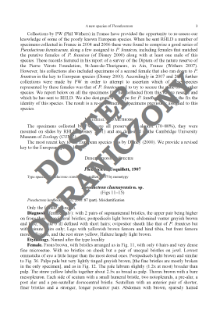- Search in all Repository
- Literature and maps
- Archeology
- Mills database
- Natural sciences
Advanced search
Advanced search
Advanced search
Advanced search
Advanced search

Object
Title: Apoidea (Hymenoptera) caught in yellow traps during spring and summer in agricultural landscape near Wrocław (Lower Silesia, Poland)
Creator:
Gabryś, Beata ; Celary, Waldemar (1960– ) ; Sobota, Grażyna ; Polska Akademia Nauk. Muzeum i Instytut Zoologii
Date issued/created:
Resource type:
Subtitle:
Fragmenta Faunistica, vol. 46, no. 2 ; Apoidea of agricultural landscape near Wrocław ; Apoidea (Hymenoptera) odłowione do żółtych pułapek w sezonie wiosenno-letnim w krajobrazie rolniczym w okolicach Wrocławia (Dolny Śląsk, Polska)
Publisher:
Museum and Institute of Zoology, PAS
Place of publishing:
Description:
Bibliogr. p. 180-181 ; P. 171-181 : ill. ; 25 cm ; Abstarct in Polish. Taxa in Latin.
Type of object:
Abstract:
Species diversity of bees and its ecological background were investigated in agricultural environment near Wroclaw during spring/summer of 1999 and 2000. 1194 bees of seven families, 21 genera, and 72 species were collected. The most abundant were Andrenidae (30 species and 34,6% of all collected Apoidea), Halictidae (26 species and 33,9% of all Apoidea), and Apidae (5 species and 29,6% of all Apoidea). The most abundant species were Apis melliferaL. (150 individuals; 12,6% of all collected bees), Andrena dorsata (KIRBY) (108; 9%), Evylaeus calceatus (SCOPOLI) (90; 7,5%), Seladonia tumulorum (L.) (75; 6,3%), and A. flavipes (PANZER) (73; 6,1%). Almost all Apoidea were collected within the winter oilseed rape field (40%), in winter wheat (22%), and in the thickets (12%). Within the thickets, mostly Andrenidae and Halictidae were caught, while in oilseed rape and in winter andspring wheat the most numerous were Apidae and Halictidae. The most diversified fauna of Apoidea was found in winter oilseed rape – 42 species, and winter wheat –39 species. Such high diversity and profusion of wild Apoideain the studied area may be attributed to the mosaic structure of the landscape: the proximity of woods, presence of midfield thickets and stripes of flowering herbs that provide food, refuge and nesting space for these bees.
Relation:
Volume:
Issue:
Start page:
End page:
Detailed Resource Type:
Format:
Resource Identifier:
oai:rcin.org.pl:54526 ; 10.3161/00159301FF2003.46.2.171
Source:
MiIZ PAN, call no. P.256, T. 46 nr 2 ; MiIZ PAN, call no. P.4664, T. 46 nr 2 ; click here to follow the link
Language:
Rights:
Rights Reserved - Restricted Access
Terms of use:
Digitizing institution:
Museum and Institute of Zoology of the Polish Academy of Sciences
Original in:
Library of the Museum and Institute of Zoology of the Polish Academy of Sciences
Projects co-financed by:
Programme Innovative Economy, 2010-2014, Priority Axis 2. R&D infrastructure ; European Union. European Regional Development Fund
Access:
Object collections:
- Digital Repository of Scientific Institutes > Partners' collections > Museum and Institute of Zoology PAS > Scientific Journals
- Digital Repository of Scientific Institutes > Partners' collections > Museum and Institute of Zoology PAS > MIZ PAN Publications > Fragmenta Faunistica
- Digital Repository of Scientific Institutes > Literature > Journals/Articles
Last modified:
Feb 4, 2025
In our library since:
Jun 24, 2015
Number of object content downloads / hits:
87
All available object's versions:
https://rcin.org.pl./publication/61150
Show description in RDF format:
Show description in RDFa format:
Show description in OAI-PMH format:
Objects Similar
Cierzniak, Tomasz (1961–2006) Polska Akademia Nauk. Muzeum i Instytut Zoologii
Šlâhtenok, Aleksandr Sergeevič Polska Akademia Nauk. Muzeum i Instytut Zoologii
Banaszak, Józef (1947– ) Państwowe Wydawnictwo Naukowe (1951–1992) Polska Akademia Nauk. Instytut Zoologii
Sawoniewicz, Janusz Polska Akademia Nauk. Muzeum i Instytut Zoologii
Skibińska, Ewa (1946– ) Polska Akademia Nauk. Muzeum i Instytut Zoologii
Banaszak, Józef Kowalczyk, Jan Krzysztof
Buszko, Jarosław (1952– ) Winiarska, Grażyna (1951– ) Polska Akademia Nauk. Muzeum i Instytut Zoologii
Banaszak, Józef (1947– ) Polska Akademia Nauk. Muzeum i Instytut Zoologii

 INSTYTUT ARCHEOLOGII I ETNOLOGII POLSKIEJ AKADEMII NAUK
INSTYTUT ARCHEOLOGII I ETNOLOGII POLSKIEJ AKADEMII NAUK
 INSTYTUT BADAŃ LITERACKICH POLSKIEJ AKADEMII NAUK
INSTYTUT BADAŃ LITERACKICH POLSKIEJ AKADEMII NAUK
 INSTYTUT BADAWCZY LEŚNICTWA
INSTYTUT BADAWCZY LEŚNICTWA
 INSTYTUT BIOLOGII DOŚWIADCZALNEJ IM. MARCELEGO NENCKIEGO POLSKIEJ AKADEMII NAUK
INSTYTUT BIOLOGII DOŚWIADCZALNEJ IM. MARCELEGO NENCKIEGO POLSKIEJ AKADEMII NAUK
 INSTYTUT BIOLOGII SSAKÓW POLSKIEJ AKADEMII NAUK
INSTYTUT BIOLOGII SSAKÓW POLSKIEJ AKADEMII NAUK
 INSTYTUT CHEMII FIZYCZNEJ PAN
INSTYTUT CHEMII FIZYCZNEJ PAN
 INSTYTUT CHEMII ORGANICZNEJ PAN
INSTYTUT CHEMII ORGANICZNEJ PAN
 INSTYTUT FILOZOFII I SOCJOLOGII PAN
INSTYTUT FILOZOFII I SOCJOLOGII PAN
 INSTYTUT GEOGRAFII I PRZESTRZENNEGO ZAGOSPODAROWANIA PAN
INSTYTUT GEOGRAFII I PRZESTRZENNEGO ZAGOSPODAROWANIA PAN
 INSTYTUT HISTORII im. TADEUSZA MANTEUFFLA POLSKIEJ AKADEMII NAUK
INSTYTUT HISTORII im. TADEUSZA MANTEUFFLA POLSKIEJ AKADEMII NAUK
 INSTYTUT JĘZYKA POLSKIEGO POLSKIEJ AKADEMII NAUK
INSTYTUT JĘZYKA POLSKIEGO POLSKIEJ AKADEMII NAUK
 INSTYTUT MATEMATYCZNY PAN
INSTYTUT MATEMATYCZNY PAN
 INSTYTUT MEDYCYNY DOŚWIADCZALNEJ I KLINICZNEJ IM.MIROSŁAWA MOSSAKOWSKIEGO POLSKIEJ AKADEMII NAUK
INSTYTUT MEDYCYNY DOŚWIADCZALNEJ I KLINICZNEJ IM.MIROSŁAWA MOSSAKOWSKIEGO POLSKIEJ AKADEMII NAUK
 INSTYTUT PODSTAWOWYCH PROBLEMÓW TECHNIKI PAN
INSTYTUT PODSTAWOWYCH PROBLEMÓW TECHNIKI PAN
 INSTYTUT SLAWISTYKI PAN
INSTYTUT SLAWISTYKI PAN
 SIEĆ BADAWCZA ŁUKASIEWICZ - INSTYTUT TECHNOLOGII MATERIAŁÓW ELEKTRONICZNYCH
SIEĆ BADAWCZA ŁUKASIEWICZ - INSTYTUT TECHNOLOGII MATERIAŁÓW ELEKTRONICZNYCH
 MUZEUM I INSTYTUT ZOOLOGII POLSKIEJ AKADEMII NAUK
MUZEUM I INSTYTUT ZOOLOGII POLSKIEJ AKADEMII NAUK
 INSTYTUT BADAŃ SYSTEMOWYCH PAN
INSTYTUT BADAŃ SYSTEMOWYCH PAN
 INSTYTUT BOTANIKI IM. WŁADYSŁAWA SZAFERA POLSKIEJ AKADEMII NAUK
INSTYTUT BOTANIKI IM. WŁADYSŁAWA SZAFERA POLSKIEJ AKADEMII NAUK




































